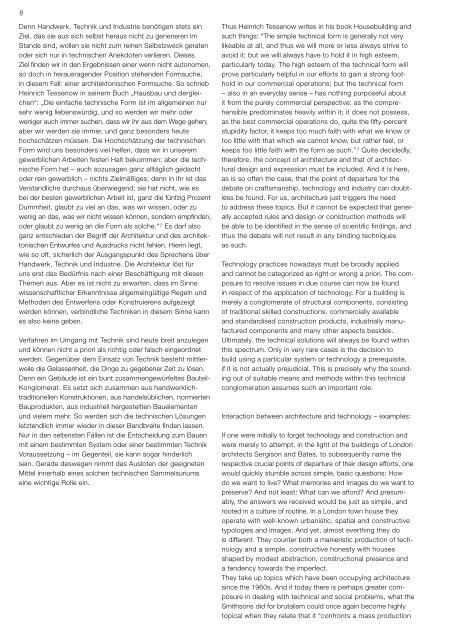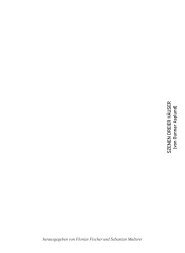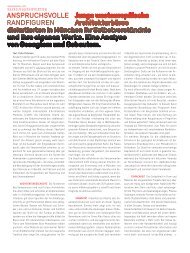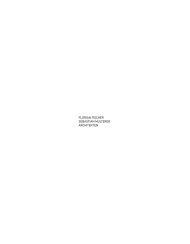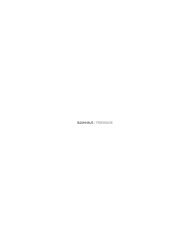werkbundsiedlung wiesenfeld 5 werkbundtage 2: material und technik
werkbundsiedlung wiesenfeld 5 werkbundtage 2: material und technik
werkbundsiedlung wiesenfeld 5 werkbundtage 2: material und technik
Erfolgreiche ePaper selbst erstellen
Machen Sie aus Ihren PDF Publikationen ein blätterbares Flipbook mit unserer einzigartigen Google optimierten e-Paper Software.
Denn Handwerk, Technik <strong>und</strong> Industrie benötigen stets ein<br />
Ziel, das sie aus sich selbst heraus nicht zu generieren im<br />
Stande sind, wollen sie nicht zum reinen Selbstzweck geraten<br />
oder sich nur in technischen Anekdoten verlieren. Dieses<br />
Ziel finden wir in den Ergebnissen einer wenn nicht autonomen,<br />
so doch in herausragender Position stehenden Formsuche,<br />
in diesem Fall: einer architektonischen Formsuche. So schrieb<br />
Heinrich Tessenow in seinem Buch „Hausbau <strong>und</strong> dergleichen“:<br />
„Die einfache technische Form ist im allgemeinen nur<br />
sehr wenig liebenswürdig, <strong>und</strong> so werden wir mehr oder<br />
weniger auch immer suchen, dass wir ihr aus dem Wege gehen;<br />
aber wir werden sie immer, <strong>und</strong> ganz besonders heute<br />
hochschätzen müssen. Die Hochschätzung der technischen<br />
Form wird uns besonders viel helfen, dass wir in unserem<br />
gewerblichen Arbeiten festen Halt bekommen; aber die technische<br />
Form hat – auch sozusagen ganz alltäglich gedacht<br />
oder rein gewerblich – nichts Zielmäßiges; denn in ihr ist das<br />
Verstandliche durchaus überwiegend; sie hat nicht, wie es<br />
bei der besten gewerblichen Arbeit ist, ganz die fünfzig Prozent<br />
Dummheit, glaubt zu viel an das, was wir wissen, oder zu<br />
wenig an das, was wir nicht wissen können, sondern empfinden,<br />
oder glaubt zu wenig an die Form als solche.“ 2 Es darf also<br />
ganz entschieden der Begriff der Architektur <strong>und</strong> des architek-<br />
tonischen Entwurfes <strong>und</strong> Ausdrucks nicht fehlen. Hierin liegt,<br />
wie so oft, sicherlich der Ausgangspunkt des Sprechens über<br />
Handwerk, Technik <strong>und</strong> Industrie. Die Architektur löst für<br />
uns erst das Bedürfnis nach einer Beschäftigung mit diesen<br />
Themen aus. Aber es ist nicht zu erwarten, dass im Sinne<br />
wissenschaftlicher Erkenntnisse allgemeingültige Regeln <strong>und</strong><br />
Methoden des Entwerfens oder Konstruierens aufgezeigt<br />
werden können, verbindliche Techniken in diesem Sinne kann<br />
es also keine geben.<br />
Verfahren im Umgang mit Technik sind heute breit anzulegen<br />
<strong>und</strong> können nicht a priori als richtig oder falsch eingeordnet<br />
werden. Gegenüber dem Einsatz von Technik besteht mittlerweile<br />
die Gelassenheit, die Dinge zu gegebener Zeit zu lösen.<br />
Denn ein Gebäude ist ein bunt zusammengewürfeltes Bauteil-<br />
Konglomerat. Es setzt sich zusammen aus handwerklich-<br />
traditionellen Konstruktionen, aus handelsüblichen, normierten<br />
Bauprodukten, aus industriell hergestellten Bauelementen<br />
<strong>und</strong> vielem mehr. So werden sich die technischen Lösungen<br />
letztendlich immer wieder in dieser Bandbreite finden lassen.<br />
Nur in den seltensten Fällen ist die Entscheidung zum Bauen<br />
mit einem bestimmten System oder einer bestimmten Technik<br />
Voraussetzung – im Gegenteil, sie kann sogar hinderlich<br />
sein. Gerade deswegen nimmt das Ausloten der geeigneten<br />
Mittel innerhalb eines solchen technischen Sammelsuriums<br />
eine wichtige Rolle ein.<br />
Thus Heinrich Tessenow writes in his book Housebuilding and<br />
such things: “The simple technical form is generally not very<br />
likeable at all, and thus we will more or less always strive to<br />
avoid it; but we will always have to hold it in high esteem,<br />
particularly today. The high esteem of the technical form will<br />
prove particularly helpful in our efforts to gain a strong foothold<br />
in our commercial operations; but the technical form<br />
– also in an everyday sense – has nothing purposeful about<br />
it from the purely commercial perspective; as the compre-<br />
hensible predominates heavily within it; it does not possess,<br />
as the best commercial operations do, quite the fifty-percent<br />
stupidity factor, it keeps too much faith with what we know or<br />
too little with that which we cannot know, but rather feel, or<br />
keeps too little faith with the form as such.” 2 Quite decidedly,<br />
therefore, the concept of architecture and that of architec-<br />
tural design and expression must be included. And it is here,<br />
as is so often the case, that the point of departure for the<br />
debate on craftsmanship, technology and industry can doubtless<br />
be fo<strong>und</strong>. For us, architecture just triggers the need<br />
to address these topics. But it cannot be expected that generally<br />
accepted rules and design or construction methods will<br />
be able to be identified in the sense of scientific findings, and<br />
thus the debate will not result in any binding techniques<br />
as such.<br />
Technology practices nowadays must be broadly applied<br />
and cannot be categorized as right or wrong a priori. The com-<br />
posure to resolve issues in due course can now be fo<strong>und</strong><br />
in respect of the application of technology. For a building is<br />
merely a conglomerate of structural components, consisting<br />
of traditional skilled constructions, commercially available<br />
and standardised construction products, industrially manufactured<br />
components and many other aspects besides.<br />
Ultimately, the technical solutions will always be fo<strong>und</strong> within<br />
this spectrum. Only in very rare cases is the decision to<br />
build using a particular system or technology a prerequisite,<br />
if it is not actually prejudicial. This is precisely why the so<strong>und</strong>ing<br />
out of suitable means and methods within this technical<br />
conglomeration assumes such an important role.<br />
Interaction between architecture and technology – examples:<br />
If one were initially to forget technology and construction and<br />
were merely to attempt, in the light of the buildings of London<br />
architects Sergison and Bates, to subsequently name the<br />
respective crucial points of departure of their design efforts, one<br />
would quickly stumble across simple, basic questions: How<br />
do we want to live? What memories and images do we want to<br />
preserve? And not least: What can we afford? And presumably,<br />
the answers we received would be just as simple, and<br />
rooted in a culture of routine. In a London town house they<br />
operate with well-known urbanistic, spatial and constructive<br />
typologies and images. And yet, almost everthing they do<br />
is different. They counter both a manieristic production of tech-<br />
nology and a simple, constructive honesty with houses<br />
shaped by modest abstraction, constructional presence and<br />
a tendency towards the imperfect.<br />
They take up topics which have been occupying architecture<br />
since the 1960s. And if today there is perhaps greater com-<br />
posure in dealing with technical and social problems, what the<br />
Smithsons did for brutalism could once again become highly<br />
topical when they relate that it “confronts a mass production


